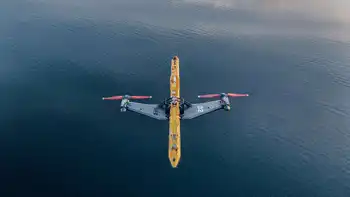Solar job market offers bright future
ONTARIO - Sean Moore had worked in a Ford plant for 12 years when the auto industry crashed in 2008.
Out of the blue, the manufacturing engineer found himself among the thousands of workers in Windsor, Ont., who were suddenly wrenched from what they thought were secure, life-long jobs.
“It was devastating,” says Mr. Moore, 39.
But not for long.
“You only get to go around once,” he says. “You might as well challenge yourself.”
Three years of hard work later, Mr. Moore is president of Unconquered Sun, a company with 25 employees – expanding to 50 by July – that assembles and installs solar photovoltaic systems, which use the sun’s energy to generate electricity.
The company operates out of a former auto-parts factory.
Mr. MooreÂ’s story and business location are both typical of a major shift in OntarioÂ’s economy.
With carmakers and other traditional manufacturing on the decline, renewable-energy companies – with strong provincial support – are taking up some of the slack. The government aims to have 50,000 people working in the sector by the end of next year.
Solar is among the most promising sources of those jobs.
The industry combines small, locally owned, businesses such as Mr. MooreÂ’s and large, international corporations. Those aiming to develop solar installations are attracted by premium prices paid for electricity generated from renewable sources. A regulation that, as of January 1, requires solar projects to include at least 60 per cent Ontario content fuels the manufacturing boom.
Other provinces are investigating solar power, but Ontario dominates the industry in Canada and is second in North America.
“There’s just no contest,” says Elizabeth McDonald, of the Ottawa-based Canadian Solar Industries Association. “Ontario is the California of Canada in terms of solar.”
The government says 30 clean-energy companies have launched or expanded in Ontario since 2009, when the Green Energy Act authorized establishment of North AmericaÂ’s first feed-in tariff program.
The tariff pays 44.3 to 80.2 cents per kilowatt-hour for electricity from solar installations. Rooftop installations earn a higher rate than those on the ground smaller projects get more than larger ones.
All the rates are far above the wholesale price for electricity, about four cents per kilowatt-hour, or what residential customers pay: less than 7.5 cents.
“It is a generous rate of return,” says Energy and Infrastructure Minister Brad Duguid. “We felt, we’ve got an opportunity. If we jump out ahead of the world… we have the potential to be a big player in the world market.”
So far, “we’ve exceeded all expectations.”
The industry association estimates that last year, solar-related companies employed 3,000 people in Ontario. “By 2013, there could be 25,000,” says Ms. McDonald.
To date, more than 200 megawatts of solar capacity has been built in Ontario, with another 1,200 under contract. Projects range from tiny residential rooftop installations generating less than 10 kilowatts to “farms” that cover hundreds of hectares and can produce dozens of megawatts.
Their construction is creating thousands of short-term jobs. One example is the 800 employed to build Enbridge Inc.’s 80-megawatt Sarnia solar farm – the world’s largest in operation.
Toronto-based SkyPower has been awarded the most solar-generation contracts under the tariff program, but global giants are also developing these projects, often linking with local manufacturers to meet the domestic-content rule.
South KoreaÂ’s Samsung received guaranteed access to the grid for solar and wind projects in return for a commitment to manufacture in Ontario. An announcement on solar production is expected soon, Mr. Duguid says.
Multinational powerhouses MEMC and Flextronics will make solar panels in Newmarket, north of Toronto, for generation projects to by built by Maryland-based SunEdison, a solar energy producer active in the province. That plant will employ up to 400 people.
SunEdison buys frames for its projects from Samco Machinery, in the Toronto suburb of Scarborough. The parts maker laid off most of its employees when the auto industry declined. The move to solar created 60 jobs, allowing many to return.
Other manufacturers include:
• Canadian Solar, with up to 500 manufacturing jobs in Guelph.
• Ottawa-based ATS, adding 150 jobs at the Waterloo solar-panel plant.
• SunGrow Canada Inc. with North American headquarters in Vaughan, where 50 people will make inverters.
• SatCon Power Systems, in Burlington, expanding its work force to 158.
• Europe’s Siliken S.A., to employ 175 at a Windsor solar-module plant.
• Solar Source Corporation, to employ up to 200 making solar panels in Windsor.
Silfab Ontario Inc., subsidiary of an Italian company, will employ up to 200 at a solar panel factory in Mississauga.
Kristopher Stevens, executive-director of the Toronto-based Ontario Sustainable Energy Association reports that on a recent trip to South Korea, 200 renewable energy companies – most in solar – expressed interest in Ontario.
Mr. Moore created Unconquered Sun — which assembles solar arrays from locally manufactured tubular steel and photovoltaic cells imported from Asia — after he “sat down and thought about the challenges of the future,” and decided “energy would be major.” The combination of Windsor’s resources and the provincial incentives made solar a natural, he says.
Windsor is, in fact, a hotbed of solar installation and manufacturing. The auto industryÂ’s decline left it with vacant factories as well as unemployed workers with experience in assembly and engineering.
As well, about half of North America’s population is within an eight-hour drive, notes Rakesh Naidu, director of business attraction with the Windsor-Essex Economic Development Corporation. “We were very aggressive” in seeking solar investments.
Two more plant openings, to be announced soon, are expected to create up to 500 jobs, he says.
Most manufacturers hope to export to the rest of Canada and the United States, Mr. Naidu adds. “The Ontario market is very attractive now, but the manufacturers know they have to look beyond it. That’s why they choose Windsor. It’s next to Detroit and the whole U.S. market is open to them.”
Most photovoltaic cells, the core of solar systems, used in Ontario are imported, although a handful of companies, most notably Toronto-based Morgan Solar, are working on new designs.
Research is also under way on the next generation of cells, using alternatives to silicon crystals, says Franco Gaspari, assistant professor of physics at the University of Ontario Institute of Technology, in Oshawa.
A global competition is under way to develop this new technology, Mr. Gaspari says. “We’re not unique in what we’re doing. But if we get a good solution, Ontario could take advantage.”
The feed-in tariffs are likely to be reduced when the program is reviewed this fall. ThatÂ’s not a problem if the decline is gradual, because costs are dropping, industry spokespeople say.
“We try in every place to get to the point where we’re not relying on subsidies,” says Jason Gray, Canadian manager of SunEdison.
“The faster we get there, the better for the industry,” says Ms. McDonald.
A bigger concern is the provincial election to be held in October. Conservative Leader Tim Hudak, whose party leads the polls, has said he would scrap the tariff.
In Spain and elsewhere in Europe, jobs disappeared when subsidies were removed abruptly.
Mr. Moore doesnÂ’t want that to happen in Ontario.
The Opposition “is making political hay out of it,” he says. “The high rates were to bring manufacturing on board. I’d like that to continue for a year or two. After that, they can do what they want.”
Related News

Purdue: As Ransomware Attacks Increase, New Algorithm May Help Prevent Power Blackouts
WEST LAFAYETTE - Millions of people could suddenly lose electricity if a ransomware attack just slightly tweaked energy flow onto the U.S. power grid.
No single power utility company has enough resources to protect the entire grid, but maybe all 3,000 of the grid's utilities could fill in the most crucial security gaps if there were a map showing where to prioritize their security investments.
Purdue University researchers have developed an algorithm to create that map. Using this tool, regulatory authorities or cyber insurance companies could establish a framework that guides the security investments of power utility companies to parts of the grid at greatest…




